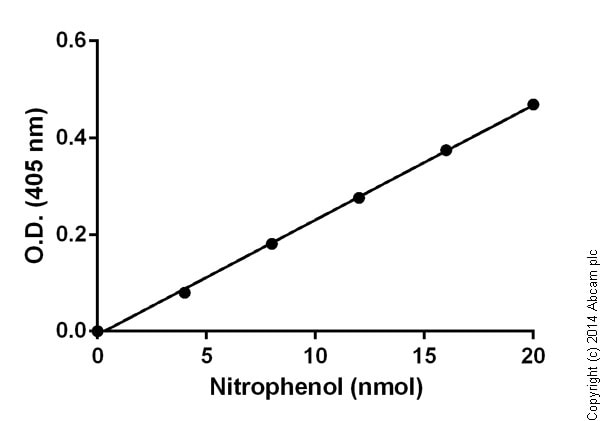Amylase Assay Kit (Colorimetric) (ab102523)
Key features and details
- Assay type: Enzyme activity (quantitative)
- Detection method: Colorimetric
- Platform: Microplate reader
- Assay time: 40 min
- Sample type: Cell culture media, Cell culture supernatant, Serum, Tissue Extracts, Urine
- Sensitivity: 0.2 mU/well
Overview
-
Product name
Amylase Assay Kit (Colorimetric) -
Detection method
Colorimetric -
Sample type
Cell culture supernatant, Urine, Serum, Tissue Extracts, Cell culture media -
Assay type
Enzyme activity (quantitative) -
Sensitivity
> 0.2 mU/well -
Assay time
0h 40m -
Species reactivity
Reacts with: Mammals, Other species -
Product overview
Amylase Assay Kit (Colorimetric) ab102523 detects activity of α-amylase through a two-step reaction.
In the amylase assay protocol, alpha-Amylase will cleave the substrate ethylidene-pNP-G7 to produce smaller fragments that are eventually modified by alpha-glucosidase. This causes the release of a chromophore that can then be measured at OD = 405 nm.
The assay can detect α-amylase content as low as 0.2 mU.
Amylase assay protocol summary:
- add samples and standards to wells
- add reaction mix
- analyze with a microplate reader every 2-3 min for 30-60 min -
Notes
Amylases are enzymes that break starch down to sugar molecules. α-amylase is the major form of amylase found in humans and other mammals as well as an enzyme present in seeds, or in fungi (baker's yeast for instance). α-amylase is a calcium metalloenzyme, completely unable to function in the absence of calcium. In human physiology, both the salivary and pancreatic amylases are major digestive enzymes.
Abcam has not and does not intend to apply for the REACH Authorisation of customers’ uses of products that contain European Authorisation list (Annex XIV) substances.
It is the responsibility of our customers to check the necessity of application of REACH Authorisation, and any other relevant authorisations, for their intended uses. -
Platform
Microplate reader
Properties
-
Storage instructions
Store at -20°C. Please refer to protocols. -
Components Identifier 100 tests Amylase Assay Buffer NM 1 x 55ml Amylase Positive Control Red 1 vial Amylase Substrate Mix NM 1 x 5ml Nitrophenol standard Yellow 1 x 150µl -
Research areas
-
Relevance
Amylases are enzymes that break starch down to sugar molecules. Alpha-amylase is the major form of amylase found in humans and other mammals as well as an enzyme present in seeds, or in fungi (baker’s yeast for instance). Alpha-amylase is a calcium metalloenzyme, completely unable to function in the absence of calcium. In human physiology, both the salivary and pancreatic amylases are major digestive enzymes. Increased enzyme levels in humans are associated with salivary trauma; mumps due to inflammation of the salivary glands, pancreatitis and renal failure. A simple, direct and automation-ready procedure for measuring alpha-amylase activity is, therefore, very desirable.
Images
-
 Functional Studies - Amylase Assay Kit (ab102523) Image from Mondragon A et al., PLoS One. 2014;9(8):e104873. Fig 3.; doi: 10.1371/journal.pone.0104873. Reproduced under the Creative Commons license http://creativecommons.org/licenses/by/4.0/
Functional Studies - Amylase Assay Kit (ab102523) Image from Mondragon A et al., PLoS One. 2014;9(8):e104873. Fig 3.; doi: 10.1371/journal.pone.0104873. Reproduced under the Creative Commons license http://creativecommons.org/licenses/by/4.0/Plasma amylase levels were measured (using ab102523) after 75 days treatment with saline or one of three drugs. ND, normal chow diet; HFD, high fat diet. p≤0.05, *; p≤0.01, **, n = 3–7 mice.
There were no statistically significant changes in plasma amylase activity in mice that were administered with two of the drugs vs mice administered saline. However, administration of the third to animals on normal diet led to a 1.4-fold increase in amylase activity (p≤0.01, n = 3 per group) and a 1.3- fold increase in mice on a high fat diet (p≤0.01, n = 4 per group).
-
Standard curve: mean of duplicates (+/- SD) with background reads subtracted
-
Amylase activity measured in biological fluids showing activity (mU) per mL of tested sample. Samples were diluted 2 fold.
-
Amylase activity measured in tissue lysates showing activity (mU) per mg of extracted protein.
Protein concentration for samples varied from 16 mg/mL to 50 mg/mL. Samples were diluted 2 fold.
-
Sample Test









